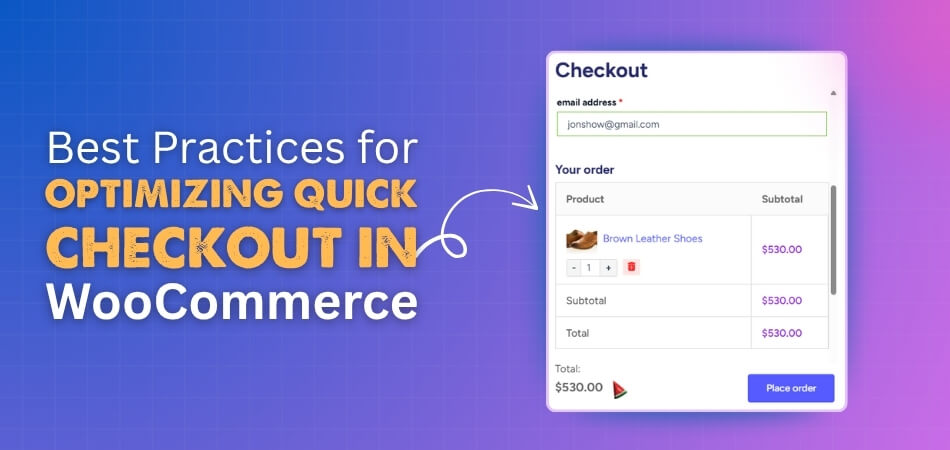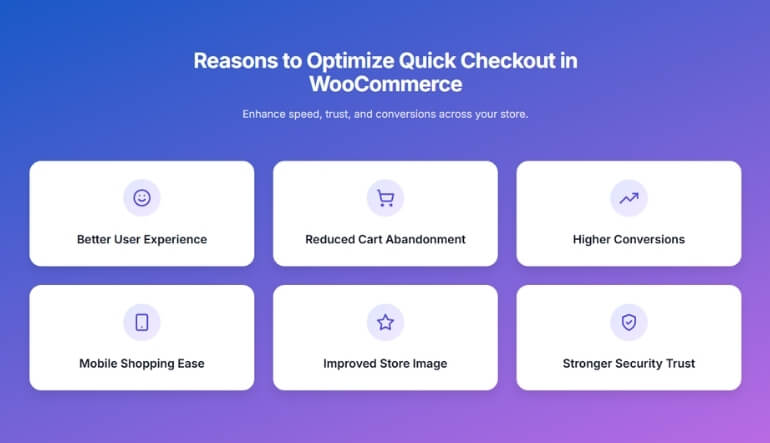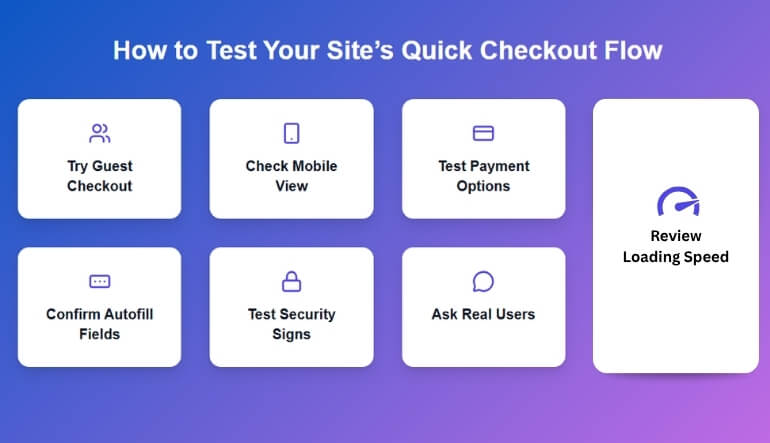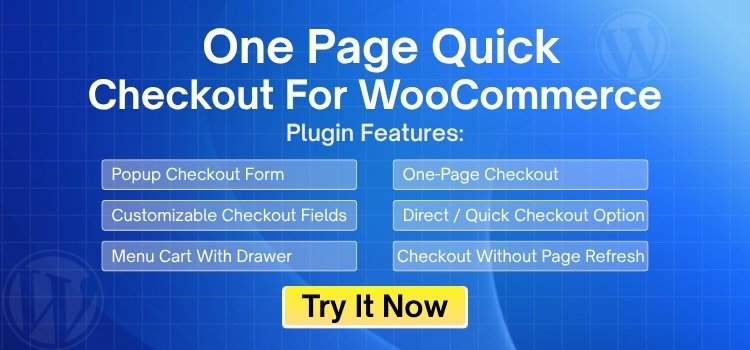People want a hassle-free shopping experience nowadays, where buying feels smooth and quick. WooCommerce quick checkout makes this possible by cutting down unnecessary steps and offering a simple flow. Many store owners wonder about what are the best practices for optimizing quick checkout in WooCommerce?
The best practices include using a clean design, reducing steps, allowing guest checkout, and enabling autofill for details. Make sure the checkout works well on mobile, supports multiple payment options, has clear call-to-action buttons, and shows security signals. Together, these features guide customers quickly from cart to confirmation, reduce cart abandonment, and boost conversions.
Want to know if your checkout is built the right way? Or curious to see what makes a simple checkout turn into a powerful sales tool? Continue reading because this article covers everything you need to know and do to improve your WooCommerce checkout speed.
What Are the Best Practices for Optimizing Quick Checkout in WooCommerce?
When people shop online, they want things to be smooth and simple. A slow or confusing checkout can make them leave without buying. That is why quick checkout is so important. Let’s look at how to make it better.

Clean Design
Keep the checkout page neat and clear. Avoid too many distractions like banners or extra links. Use simple colors and readable fonts to help customers focus only on completing their purchase. A clean design makes the process feel faster. Even small design changes can help reduce confusion and guide buyers smoothly.
Guest Checkout
Not everyone wants to create an account. Offering guest checkout lets people buy without filling in extra forms. This saves time and makes the experience easier. Later, you can give them the option to create an account if they want. This flexibility can keep more people from leaving the site before finishing.
Autofill Options
Make it simple for buyers to fill in their details. Use autofill for names, addresses, and payment information. This reduces typing and helps prevent mistakes. Customers are more likely to complete their purchase when it takes less effort. It also helps repeat buyers who shop often in your store.
Fewer Steps
Too many steps can frustrate shoppers. Try to keep the checkout to one page or only a few steps. Each extra click increases the chance they will leave. A short process feels quick and stress-free. The goal is to take buyers from cart to confirmation without delay.
Multiple Payments
People like to pay in different ways. Add popular options like credit cards, PayPal, digital wallets, and even local payment methods. More choices mean fewer chances of losing a customer at the payment stage. It also shows you care about buyer comfort. Supporting trusted payment methods builds reliability as well.
Mobile Friendly
Most shoppers use their phones to buy online. Make sure the checkout works smoothly on small screens. Buttons should be big enough to tap easily, and forms should adjust well to mobile devices. A mobile-friendly design helps everyone shop without trouble. Ignoring mobile users can cause many missed sales.
Security Signals
Shoppers want to feel safe when paying online. Show trust badges, SSL certificates, and clear refund policies. Small signs of security give customers confidence to share their payment details. Focusing on quick checkout security in WooCommerce can make a big difference in completing the sale. Simple reminders of safety lower the risk of cart abandonment.
Clear CTAs
Your checkout buttons should be easy to find and understand. Use simple words like “Pay Now” or “Complete Order.” Make the buttons stand out with color and size. Clear calls to action guide customers to finish their purchase quickly. A well-placed button can be the final push to buy.
Does Quick Checkout Perform Better Than Traditional Checkout When It’s Optimized?
Yes, an optimized quick checkout outperforms a traditional one by saving customers time and reducing distractions during the payment process. A checkout that loads faster and asks for fewer details helps shoppers complete purchases without feeling bored, frustrated, or interrupted midway. When people experience less stress online, they trust the store more and feel comfortable finishing the transaction with confidence.
Speed matters most when customers are in a hurry or shopping from their phones, where patience is usually very low. Simplified forms, fewer clicks, and clear buttons allow them to move quickly without wasting effort or making mistakes. In comparing traditional checkout vs quick checkout, the faster option proves much more effective in reducing cart abandonment rates everywhere.
Security is another big reason optimized quick checkout works better, because shoppers want safe payment systems that protect their personal details at all times. Adding visible trust signs like SSL certificates, badges, and simple refund policies gives reassurance without slowing down the process overall. So yes, an optimized quick checkout is far more powerful and reliable than the older traditional checkout process people used.
Why Should You Optimize Quick Checkout in WooCommerce?
Customers expect the online shopping experience to be simple and straightforward. Any small delay or confusion can make them leave. That is why optimizing quick checkout matters so much. Let’s look at the main reasons behind it.

Better User Experience
A quick checkout keeps the buying process simple and clear. Customers don’t waste time filling out unnecessary forms or clicking too much. When the process feels smooth, they are more likely to stay until payment. This better experience builds trust in your store.
Reduced Cart Abandonment
Long or confusing checkouts often make customers give up before buying. A faster checkout reduces that risk by removing obstacles. Shoppers appreciate not having to spend too much time. This means fewer abandoned carts and more completed orders.
Higher Conversions
Quick checkout directly impacts how many visitors turn into buyers. The simpler the process, the more people finish their purchase. This improvement can bring more sales without extra marketing efforts. It’s one of the easiest ways to boost results.
Mobile Shopping Ease
Most people shop from their phones today. If checkout is quick and mobile-friendly, customers can buy with just a few taps. A slow or cluttered page makes them leave. Optimized checkout works better on all screen sizes.
Improved Store Image
A smooth checkout leaves a good impression. Customers remember the ease and are more likely to return. They may even recommend your store to others. A positive image helps you stand out from competitors.
Stronger Security Trust
Shoppers worry about their data during checkout. Showing clear security signals helps them feel safe while paying. When customers trust your store, they complete the process confidently. Security and speed together build long-term loyalty.
Can You Optimize Your Site’s Quick Checkout Without a Plugin?
Yes, you can optimize quick checkout without using a plugin by adjusting settings, customizing fields, and simplifying unnecessary steps. Store owners can shorten forms, reduce distractions, and focus only on information that is really needed for completing purchases. However, with a plugin optimization task, it is easy to make changes faster and less technically for beginners who may not know coding.
Many store themes already include useful options for checkout customization, like changing button styles, rearranging fields, and hiding unwanted sections. By using built-in features and available theme settings, you can remove extra barriers and speed up checkout. Still, adding a plugin like one page quick checkout for woocommerce makes advanced functions more effortless and user-friendly overall.
Speed and trust matter the most when customers are ready to pay, because a smooth system encourages them to finish without hesitation. Reducing wait time, simplifying design, and ensuring visible security marks will keep customers confident throughout the process. Optimizing without plugins is possible, but plugins remain the quicker choice when aiming for strong results with less effort.
How to Test Your Site’s Quick Checkout Flow?
Every online store needs to make sure that checkout works smoothly. If customers face problems during payment, they may leave quickly. Testing your checkout helps you find and fix these problems. The following are some of the best ways to test it.

Try Guest Checkout
Check if buyers can complete a purchase without creating an account. Many prefer shopping as a guest for speed and ease. Go through the process yourself to see if everything works fine. A smooth guest checkout shows good design and reduces stress for new visitors.
Check Mobile View
Most people shop on phones, so your quick checkout must work perfectly there. Test if buttons, forms, and pages load properly. Try different screen sizes to confirm the checkout adjusts well. A mobile-friendly checkout builds confidence and keeps people from dropping their carts midway.
Test Payment Options
Customers like having choices when paying. Test each payment option carefully, including cards, wallets, and other supported methods. Make sure transactions go through without errors. Reliable payments prevent frustration and show your store can handle different customer needs with ease.
Review Loading Speed
Checkout pages should load fast. Slow pages can make customers leave before finishing. Use online tools to check speed performance. Fixing delays improves user experience and keeps sales flowing without interruptions.
Confirm Autofill Fields
Autofill saves time and reduces mistakes. Test if names, addresses, and emails fill automatically. Ensure details are correct and safe. A working autofill makes shopping easier, especially for customers who return often.
Test Security Signs
Shoppers look for trust signals before paying. Check if SSL, badges, and safety icons are showing properly. Security signs must be visible. These small details make people feel safe and ready to complete payment.
Ask Real Users
Sometimes problems are only found by others. Ask friends or testers to try buying from your store. Their feedback helps spot hidden issues. Real users give honest insight into how smooth your checkout truly feels.
Why Should You Test Checkout on Different Devices and Browsers?
Online shoppers use different devices and browsers, and a checkout that works well on one might fail on another. Regular testing is the best way to catch these issues early. By checking performance across platforms, you can ensure the checkout stays smooth and reliable for every customer. Here is why you should test checkout on different devices and browsers.
- Device Variety: Customers use phones, tablets, and desktops every day. Testing ensures checkout feels smooth on each device and screen without unexpected issues.
- Browser Differences: Browsers handle code differently, sometimes breaking important elements. Checking across browsers guarantees that buttons, forms, and payments always work correctly.
- Mobile Experience: Most shopping happens on mobile devices today. Testing ensures the checkout works well on small screens with simple taps and inputs.
- Performance Issues: Slow load times drive shoppers away quickly. Testing devices and browsers highlights speed problems, helping you improve pages for faster completion.
- Payment Reliability: Payment systems may act differently on devices. Testing ensures every payment option works smoothly so customers can pay without frustration.
- Design Consistency: Your checkout should look the same everywhere. Testing across browsers and devices helps maintain a professional, reliable image for your store.
- Error Handling: Mistakes in forms can frustrate customers. Testing shows whether error messages are clear, helpful, and consistent across devices and browsers.
- Accessibility Checks: Different setups affect accessibility features. Testing ensures checkout is usable for everyone, including those needing larger text or easier navigation.
Frequently Asked Questions
Testing, optimizing, and improving quick checkout can raise sales and create trust with customers. Many store owners have common questions about this process. Below are clear and helpful answers to make checkout improvements easier for your WooCommerce store.
How Does Quick Checkout Affect Customer Trust?
Quick checkout creates a smooth and safe feeling for customers because it reduces confusion. When checkout is fast and secure, people trust the store more. Trust helps reduce cart abandonment and builds loyalty over time.
Why Should Checkout Be Simple?
Complicated steps confuse customers and push them away. A simple checkout lets shoppers buy quickly without second thoughts. The easier the process feels, the more likely customers are to trust your store and come back for future purchases.
How Do Colors Influence Checkout Design?
Colors affect how customers feel during checkout. Bright or bold buttons guide users’ eyes to important actions like completing payment. Calmer background colors help reduce stress and make the overall experience feel professional and trustworthy, encouraging shoppers to finish.
Why Add Address Autocomplete?
Typing long addresses often frustrates customers. Address autocomplete saves time and reduces mistakes, especially for mobile users. This not only speeds up checkout but also ensures orders are processed with accurate details, lowering returns and increasing customer satisfaction overall.
How Important Is Guest Access?
Guest access makes the process flexible. Many buyers prefer skipping account creation when they are in a hurry. Offering this choice shows respect for their time and helps reduce cart abandonment, while still giving the option to register later.
Why Should Checkout Have Progress Indicators?
Progress indicators help customers understand how far they are from finishing. Seeing clear steps reduces stress and uncertainty. This visual guide encourages shoppers to continue until the final step, instead of leaving mid-way because they felt the process was endless.
How Can Clear Wording Help Checkout?
Unclear labels confuse customers. Simple, direct wording like “Place Order” or “Pay Securely” builds confidence during checkout. When instructions are short and clear, buyers don’t waste time guessing, which helps them finish their purchase smoothly and without hesitation.
Why Do People Prefer One-page Checkout?
One-page checkout reduces unnecessary steps and keeps everything visible at once. Customers don’t need to click through multiple screens. This shorter process saves time, increases satisfaction, and lowers the chance of buyers leaving before completing their order successfully.
Should Checkout Buttons Be Large?
Yes, larger buttons are easier to notice and tap, especially on phones. Clear buttons make actions obvious, reducing confusion. When customers instantly recognize how to continue, they move smoothly through checkout without unnecessary searching or hesitation at critical steps.
Why Add Multiple Languages?
Online stores serve global shoppers. Offering checkout in multiple languages makes the process inclusive and comfortable. Customers are more likely to finish purchases when they can read instructions in their preferred language, which builds trust and shows customer care.
Final Thoughts
A smooth checkout is often the final push that turns a visitor into a paying customer. If the process feels heavy or confusing, people leave even with items in their cart. That is why optimizing this stage should never be overlooked.
When you ask what are the best practices for optimizing quick checkout in WooCommerce, the answer is simple: keep it fast, secure, and clear. Small improvements like fewer steps, guest checkout, and mobile-friendly design make a big difference in results. Testing across devices and browsers ensures nothing blocks customers from finishing purchases.
The goal is always to make buying effortless. When customers enjoy a seamless checkout, they are more likely to return, recommend, and trust your store.
